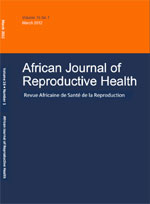
|
African Journal of Reproductive Health
Women's Health and Action Research Centre
ISSN: 1118-4841
Vol. 24, No. 2, 2020, pp. 123-128
|
 Bioline Code: rh20029
Bioline Code: rh20029
Full paper language: English
Document type: Research Article
Document available free of charge
|
|
|
African Journal of Reproductive Health, Vol. 24, No. 2, 2020, pp. 123-128
| fr |
Okohue, Jude E.
Résumé
L'effet de l'épaisseur de l'endomètre sur le résultat de la fécondation in vitro (IVF) est toujours un sujet de débat. On ne sait pas
pourquoi un endomètre mince réduit les taux de réussite de la IVF. Notre objectif était d'analyser les résultats hystéroscopiques
chez les femmes devant subir une FIV qui avaient une épaisseur endométriale inférieure à 7 mm. Données pertinentes des
patientes programmées pour des cycles de IFV et ayant une épaisseur endométriale (ET) <7 mm à l'échographie transvaginale
(TVS) entre le 1er avril 2010 et le 31 mars 2017, dans une unité de chirurgie privée de fertilité et d'accès minimal à la région du
Niger-Delta au Nigeria, ont été récupérées et documentées. Un total de 41 patients avaient ET <7 mm au cours de la période
d'étude. Ces patients représentaient 2,8% des 1487 cycles de IVF effectués au cours de la même période. Les 41 patients ont subi
une hystéroscopie en cabinet, ce qui représente 4,1% des 1 002 hystéroscopies réalisées au cours de la période d'étude. La tranche
d'âge des patients était de 23 à 50 ans avec une moyenne de 39,9 ± 6,9 ans, et la durée de l'infertilité variait de 3 à 13 ans avec
une moyenne de 7,2 ± 2,5 ans. La plupart des patients (32, 78,1%) avaient une infertilité secondaire. Seize patients (39,0%)
avaient des adhérences intra-utérines. Un endomètre mince, bien que peu fréquent pendant les cycles de traitement de IVF,
pourrait être associé à des adhérences intra-utérines non diagnostiquées. (Afr J Reprod Health 2020; 24[2]: 123-128).
Mots Clés
Mince, endomètre, hystéroscopie, IVF, infertilité, adherences
|
| |
| en |
Hysteroscopy Findings in Women with Thin Endometrium Scheduled for In Vitro fertilization in Niger Delta Region, Nigeria
Okohue, Jude E.
Abstract
The effect of endometrial thickness on in vitro fertilization (IVF) outcome is still a subject of debate. It is unclear why a thin
endometrium reduces IVF success rates. Our objective was to analyze the hysteroscopic findings in women scheduled for IVF
who had an endometrial thickness less than 7 mm. Relevant data of patients scheduled for IVF cycles and found to have an
endometrial thickness (ET) of <7 mm on transvaginal ultrasound scan (TVS) between April 1, 2010 and March 31, 2017, at a
private fertility and minimal access surgery unit in the Niger-Delta region of Nigeria, were retrieved and documented. A total of
41 patients had ET <7 mm during the study period. These patients accounted for 2.8% of the 1487 IVF cycles performed during
the same period. All 41 patients had office hysteroscopies performed, constituting 4.1% of the 1,002 hysteroscopies performed
during the study period. The age range of the patients was 23 – 50 years with a mean of 39.9 ± 6.9 years, and the duration of
infertility ranged from 3 to 13 years with a mean of 7.2 ± 2.5 years. Most of the patients (32, 78.1%) had secondary infertility.
Sixteen patients (39.0%) had intrauterine adhesions. A thin endometrium, though infrequent during IVF treatment cycles, might
be associated with undiagnosed intrauterine adhesions. (Afr J Reprod Health 2020; 24[2]: 123-128).
Keywords
Thin, endometrium, hysteroscopy, IVF, infertility, adhesions
|
| |
© Copyright 2020 - African Journal of Reproductive Health
Alternative site location: http://www.ajrh.info
|
|
